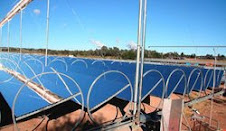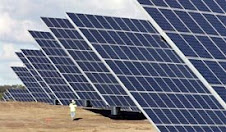India's Powerful Dilemma
by Paul Maidment, Forbes.com
Over the past quarter of a century, India's energy consumption has tripled. The rate of growth is faster than China's, albeit from a lower base, though the causes are the same: rapid economic development, a large and growing population and increasing urbanization. So is the potential threat to air quality and water supplies.
Even under conservative estimates of growth, India's energy requirements are likely to increase by a further third in the second half of this decade, driven by industry, transportation and domestic electricity consumption as living standards rise. Yet India's ambition to grow its economy at a long-term annual rate of 8% is running up against an energy constraint.
Solving it will require continued reliance on fossil fuels--notably coal--greater energy imports and root-and-branch reform of electricity generation, which in India is an inadequate, insufficient and insolvent provision of power that is already causing environmental damage to water supplies.
India currently uses coal for about half of its energy needs. Few see that share changing much over the next two decades, even as overall energy use grows. The country risks creating the same environmental problems for itself that now confront China? (See "Pollution and Prosperity.")
India already has energy-related water shortages. The country's legions of small farmers are heavily subsidized to pump water for irrigation. This not only drains an unreliable and insufficient supply of rural power but also depletes water tables across the subcontinent. This creates a vicious cycle. Lower water tables require farmers to consume more energy to pump ever-deeper water supplies with ever larger pumps. This, in turn, puts more strain on power supplies and contributes to higher levels of greenhouse gases.
Electricity reform is central to both India's economic development and its environmental protection. India produces a lot of electricity, but 30% to 50% is lost along the delivery chain. Utilities that collectively lose $7 billion a year not only fail to deliver the power needed but are soaking up billions of rupees in bail-outs--money that could otherwise be spent on education and health services.
The government has been liberalizing the sector for the past 15 years, but progress is slow, despite the priority given to distribution reform. Thousands of villages are still off-grid, and power shortages in cities are common.
Power generation accounts for most of the coal consumed in India, with heavy industry a distant second. Most electricity is generated from pollution-generating, high-ash coal. The government is promoting a switch from coal-fired to natural-gas plants for power generation and cutting subsidies for low-quality coal--part of a general move to market pricing for energy and anti-pollution measures.
That is happening slowly, too. Replacing existing coal-fired plants is a capital-intensive and time-consuming process. Many of India's highly polluting, low-efficiency coal-fired power plants will stay in operation for years to come. The most feasible alternative, natural gas, has seen its share of India's energy consumption rise from 1.4% in 1980 to only 7% today.
While natural gas is at the heart of the government's policy for cleaner power generation and fertilizer production for the country's huge farm sector, India faces potential problems. Its natural gas imports come from Turkmenistan, Bangladesh, Iran, Miramar--all places that raise questions about the reliability of supply. India's own untapped natural gas fields lie under deep seas.
Renewables are not seen to be feasible on a commercial scale in the foreseeable future. India has one of the largest national programs to promote the use of solar energy, but unlike many developed countries that have turned to solar energy mainly out of concern about the environment and energy security, solar power in India is seen as a cost-effective way to provide energy to small villages and remote areas off the national grid where there is a shortage of electricity.
Nuclear power may by the long-term alternative to coal, but for now, there is little that will check the rapid growth of India's carbon emissions--rising faster than even China's. India has not made the same progress in energy efficiency as China. Its ability to wring economic growth out of each unit of energy it consumes has remained flat for two decades, whereas China has improved markedly.
A big reason is the lack of energy efficiency and conservation measures in most industries at the local level. Ever since the Bhopal disaster in 1984, India has had strong environment protections enshrined in law. However, their effectiveness diminishes due to a lack of enforcement that grows laxer the closer administration gets to the local level.
Thus, air pollution has become India's most severe environmental problem, and one that is likely to continue to worsen. India's per capita carbon emissions are relatively low, at 1.2 metric tons of carbon per person in 2003. (China's emissions were 3.2 metric tons per person, and the U.S.'s 19.8). But India's emissions are forecast to triple by 2020 due to the rapid pace of urbanization, increased use of cars and trucks and the continued use of older and more inefficient coal-fired plants for power generation.
As in China, continued urbanization has exacerbated the problem of rapid industrialization. Cities are frequently unable to implement adequate pollution control, and some India cities--including New Delhi, Mumbai, Chennai and Kolkata--are among the world's most polluted. Urban air quality ranks among the world's worst.
Also as in China, sheer population growth and urbanization make it all the more difficult to pull off the balancing trick of continuing to generate economic growth without destroying the quality of life in both the cities and villages. But unlike China, India has a strained power generation, transmission and distribution infrastructure that is already hampering growth.
For more info:
Alternative Energy Website
Best Green Stocks Investing Blog
Subscribe to:
Post Comments (Atom)
Yuya Joe Blog
Lake Ontario Waterkeeper
The Daily Beast -Politics Blog
21stArch.com - 21st Century Architecture
Original Joe College Blog
WikiLeaks Foreign Policy Analysis
AGreenRealtor.com Real Estate Blog - Ecology Energy Efficiency
Best Green Stocks Investing Blog
PV Intell Photovoltaic Solar Stocks Investing
SEARCH Leading Alternative Energy and Ethical Investing websites

Custom Search
Daily Kos
Rare Earth Stocks Research
Patrick MacManus's Blog Peace and Collaborative Development
BeesTreesFrogsElephants.com - Nature and Ecology Blog
Research Green Energy stocks, Clean Energy investing information
Find wind power investing info online, clean energy mutual funds, geothermal stocks, solar energy investments.

Green Energy Investing Network:
Green Stocks Investing Clean Power Blog
SolarIntell.com Renewable Power Investing Website
Wind Intell.com Wind Energy Stocks Company Links
Geothermal Power Investing Public Companies
PV Intell.com Leading Photovoltaic Solar Energy Stocks

Custom Search
Green Energy Investing Network:
Green Stocks Investing Clean Power Blog
SolarIntell.com Renewable Power Investing Website
Wind Intell.com Wind Energy Stocks Company Links
Geothermal Power Investing Public Companies
PV Intell.com Leading Photovoltaic Solar Energy Stocks







No comments:
Post a Comment